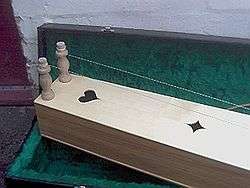Fiðla


The fiðla (Icelandic pronunciation: [ˈfɪðla]) is a traditional Icelandic instrument that can be described as a box with two brass strings which is played with a bow. The strings stretch across one end of the box to the other where they are tuned by two tuning pegs.
In English the fiola is known as a fiddle or violin. It was known to be used in the medieval ages when the King of Sweden kept both fiola and harp players in his court. The fiola has also been seen in the medieval cathedral of Nidaros in Norway where statues of people playing the fiola are displayed.[1]
History
The instrument was first introduced in a folktale in the 16th century although it was not clearly described until the 18th century by Jón Ólafsson who described the instrument as a cavernous box. Later in the 18th century, the Swedish explorer Uno von Troil, visited Iceland in 1722 where he wrote about a langspil and fiola and noted that each were played with bows. Displayed in the National Museum of Iceland is a drawing of the famous fiola player, Sveinn Þórarinsson. Not much else is known about the instrument and its uses began to die out by the middle of the 19th century.[2]
Construction and Design
The fiola is a long box made up of thin wood that is about 78 cm long and narrows from 17 cm on one end to 14 cm on the other end. Each of the tuning pegs which are about 13 cm long are at the bottom end of the instrument. Each of the two strings on the fiola are nailed in on each side to make the strings parallel to the fiola.[3]
External links
Video demonstration of the fiola.
References
- ↑ "Langspil and Icelandic Fiola" (PDF). Hildur Heimisdóttir. Retrieved September 16, 2016.
- ↑ "Funi Bára Grímsdóttir & Chris Foster Icelandic folk music kan". Funi Bára Grímsdóttir & Chris Foster Icelandic folk music kan. Retrieved 2016-09-17.
- ↑ "Langspil and Icelandic Fiola" (PDF). Hildur Heimisdóttir. Retrieved September 16, 2016.
Similar instruments
- Gue, a lost Shetland instrument which may have resembled the fiðla
- Langspil
- Tautirut, a bowed zither played by the Inuit of Hudson Bay